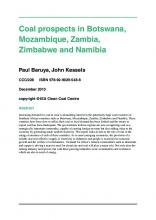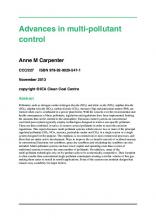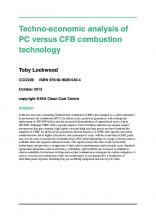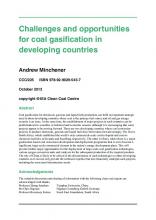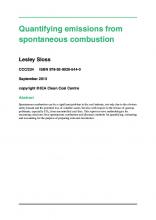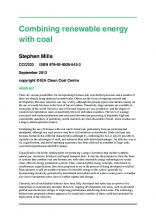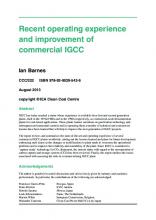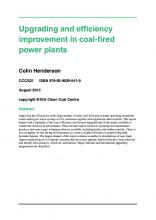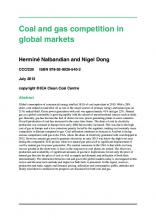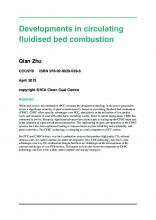December 1st, 2013
CCC/228 ISBN 978-92-9029-548-8
December 2013
copyright © IEA Clean Coal Centre
Abstract
Increasing demand for coal in Asia is stimulating interest in the potentially large coal resources in
Southern African countries such as Botswana, Mozambique, Zambia, Zimbabwe and Namibia. These
countries have been slow to utilise their coal as local demand has been limited and the means to
export coal has been inadequate. The governments in these regions are now recognising coal as a
November 1st, 2013
CCC/227 ISBN 978-92-9029-547-1
November 2013
copyright © IEA Clean Coal Centre
Abstract
Pollutants, such as nitrogen oxides (nitrogen dioxide (NO2) and nitric oxide (NO)), sulphur dioxide
(SO2), sulphur trioxide (SO3), carbon dioxide (CO2), mercury (Hg) and particulate matter (PM), are
formed when coal is combusted in a power plant boiler. With the concern over the environmental and
health consequences of these pollutants, legislation and regulations have been implemented limiting
October 1st, 2013
CCC/226 ISBN 978-92-9029-546-4
October 2013
copyright © IEA Clean Coal Centre
Abstract
In the last ten years circulating fluidised bed combustion (CFBC) has emerged as a viable alternative
to pulverised coal combustion (PCC) for utility-scale coal power generation, with widespread
deployment of 300 MW boilers and the successful demonstration of supercritical units of up to
600 MW. Although CFBC offers a greater degree of fuel flexibility and does not usually require
October 1st, 2013
CCC/225 ISBN 978-92-9029-545-7
October 2013
copyright © IEA Clean Coal Centre
Abstract
Coal gasification for chemicals, gaseous and liquid fuels production can fulfil an important strategic
need in those developing countries where coal is the primary fuel source and oil and gas energy
security is an issue. At the same time, the establishment of major projects in such countries can be
problematical for a number of technical and economic reasons, although it is encouraging that some
September 1st, 2013
CCC/224 ISBN 978-92-9029-544-0
September 2013
copyright © IEA Clean Coal Centre
Abstract
Spontaneous combustion can be a significant problem in the coal industry, not only due to the obvious
safety hazard and the potential loss of valuable assets, but also with respect to the release of gaseous
pollutants, especially CO2, from uncontrolled coal fires. This report reviews methodologies for
measuring emissions from spontaneous combustion and discusses methods for quantifying, estimating
September 1st, 2013
CCC/223 ISBN 978-92-9029-543-3
September 2013
copyright © IEA Clean Coal Centre
Abstract
There are various possibilities for incorporating biomass into coal-fuelled processes and a number of
these are already being deployed commercially. Others are the focus of ongoing research and
development. Biomass materials can vary widely, although the present report concentrates mainly on
the use of woody biomass in the form of forest residues. Potentially, large amounts are available in
August 1st, 2013
CCC/222 ISBN 978-92-9029-542-6
August 2013
copyright © IEA Clean Coal Centre
Abstract
IGCC has today reached a status where experience is available from first and second generation
plants, built in the 1970s/1980s and in the 1990s respectively, as commercial-scale demonstration
plants for coal-based applications. These plants feature variations on gasification technology and
subsequent environmental controls and in operating them a number of technical and commercial
August 1st, 2013
CCC/221 ISBN 978-92-9029-541-9
August 2013
copyright © IEA Clean Coal Centre
Abstract
Improving the efficiencies of the large number of older coal-fired power plants operating around the
world would give major savings in CO2 emissions together with significant other benefits. This report
begins with a summary of the ways efficiency can become degraded and of the means available to
combat the decrease in performance. These include improvements to operating and maintenance
July 1st, 2013
CCC/220 ISBN 978-92-9029-540-2
July 2013
copyright © IEA Clean Coal Centre
Abstract
Global consumption of commercial energy totalled 18 Gt of coal equivalent in 2010. With a 28%
share, coal ranked second after oil as one of the major sources of primary energy and natural gas (at
21%) ranked third. Gross power generation with coal was approximately 41% and gas 22%. Natural
gas as a global commodity is growing rapidly with the advent of unconventional sources such as shale
April 1st, 2013
CCC/219 ISBN 978-92-9029-539-6
April 2013
copyright © IEA Clean Coal Centre
Abstract
While pulverised coal combustion (PCC) remains the dominant technology in the power generation
sector, a significant minority of plant commissioned is based on circulating fluidised bed combustion
(CFBC). CFBC offers specific advantages over PCC, particularly in the utilisation of low quality
coals, and mixtures of coal with other fuels, including wastes. Since its initial deployment, CFBC has
Pages

